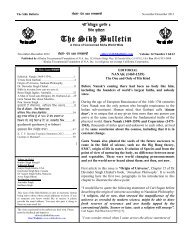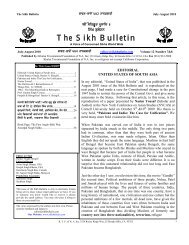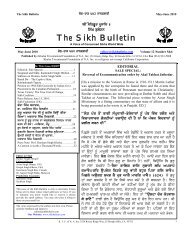You also want an ePaper? Increase the reach of your titles
YUMPU automatically turns print PDFs into web optimized ePapers that Google loves.
<strong>The</strong> <strong>Sikh</strong> <strong>Bulletin</strong> cyq-vYswK 539 March-April 2007<br />
SIKH TEMPLE MAKINDU, KENYA<br />
HISTORY<br />
Submitted by Swaran Singh Penesar<br />
Leeds, West Yorkshire, England.<br />
E-Mail: swaransinghpanesar@yahoo.com<br />
<strong>The</strong> origins of the ‘<strong>Sikh</strong> Temple Makindu’ in Kenya can<br />
be traced back to the early 1900s, when the British built<br />
the Uganda Railway to open up the interior of East<br />
Africa. <strong>The</strong> train running out of Mombasa had its first major<br />
stop at Voi and then Makindu, where an encampment was<br />
established which soon blossomed into a robust and bustling<br />
town by the 1920s. It was the days of steam locomotives<br />
chugging along slowly across the nyika where the lions<br />
reigned supreme just as the famous elephants of Tsavo. <strong>The</strong><br />
steam engines got timber fuel and water at Makindu railway<br />
station. Among the many Indians that were recruited by the<br />
British authorities to come and construct the railway line<br />
there were many pioneering <strong>Sikh</strong>s, who became part of the<br />
larger history of the <strong>Sikh</strong> contribution to the overall<br />
development of Kenya.<br />
Present Day: <strong>The</strong> Main Darbar Sahib<br />
<strong>The</strong>y were great men of clear vision, farsightedness and iron<br />
will. Many of them were lost in the tropical wilderness or<br />
picked up by the man-eating lions of Tsavo forest. A place of<br />
shelter and service was the only answer to provide help and<br />
relief to one and all. It is believed those early <strong>Sikh</strong>s would<br />
gather under a tree near the railway station every weekend to<br />
offer their prayers and thanks to Waheguru. And to those<br />
humble and hardy <strong>Sikh</strong>s to set up a Gurdwara was within<br />
their limits of strength and savings. <strong>The</strong>ir desire to establish a<br />
Gurdwara was seen as establishing a church by their bosses<br />
and colonial rulers. <strong>The</strong> British not only gave green light but<br />
also gave the <strong>Sikh</strong>s a piece of land near the station. <strong>The</strong> <strong>Sikh</strong>s<br />
were more than happy and together with their non-<strong>Sikh</strong><br />
fellows, suppliers, contractors and rich community members<br />
laid the foundation of Makindu <strong>Sikh</strong> Temple. With the<br />
installation of one of the original versions of Sri Guru Granth<br />
Sahib, the doors of the new Temple were opened in 1926 and<br />
ever since then this <strong>Sikh</strong> place of worship has continued to be<br />
a mystical inspiration to many visitors. Makindu thus became<br />
an important stop for <strong>Sikh</strong>s and other Indian train passengers,<br />
who would especially come off the train to pay their respects<br />
to the house of God. Among the founder fathers of the<br />
Temple were Bhai Tara Singh Ahluwalia, a shed master at<br />
Makindu and Bhai Lachman Das, commonly known as<br />
‘Dipti’. S Teja Singh, a guard with the Railways, performed<br />
the opening ceremony of the Temple. <strong>The</strong> <strong>Sikh</strong> Temple<br />
Makindu continued to serve the public for nearly 20 years.<br />
However, in the late 40s, following the Second World War, it<br />
became ineffective. With technological changes, the steam<br />
locomotive gave way to diesel engines; thus reducing<br />
Makindu’s importance as a refuelling and water station. Even<br />
the <strong>Sikh</strong>s living at Makindu left the place, closing the Temple<br />
and leaving an African called ‘Gwalo’ as caretaker. A<br />
window was, however, left open so that travellers between<br />
Nairobi and Mombasa could stop and pay their respects to<br />
Sri Guru Granth Sahib through the opening. In the early 50s<br />
a fire broke out and destroyed the main temple building,<br />
leaving only the Sri Guru Granth Sahib intact. At another<br />
time a plague of deadly ants ravaged the buildings, but again<br />
Sri Guru Granth Sahib remained untouched. <strong>The</strong>n one day<br />
Gwalo saw a miracle. He went and told a <strong>Sikh</strong> farmer in the<br />
area, known as Dhanna Singh that he had seen some <strong>Sikh</strong>s<br />
on horseback riding from the sky down towards the Temple.<br />
Gwalo saw a painting of Sri Guru Gobind Singh Ji at<br />
Dahnna Singh’s place and said he saw a person like that<br />
come down from the sky on a horse back. Dhanna Singh<br />
came to Nairobi and related Gwalo’s story to other <strong>Sikh</strong>s.<br />
<strong>The</strong> community was shaken by Gwalo’s story and felt the<br />
urge to do something to revive the Temple.<br />
Present Day: Lawns and Dining Hall<br />
At the same time in the late 50s, but quite independently,<br />
Sant Baba Puran Singh Ji, resident in Kericho, also received<br />
some divine message from Waheguru that the Makindu<br />
Temple had been left untended for months. He implored<br />
<strong>Sikh</strong>s in Nairobi to travel to Makindu on weekends and to<br />
restore the Temple and to clean and wash the ‘Asthaan’ with<br />
milk. <strong>The</strong> place thus began to be lively again with<br />
kirtan/diwans and recitation of gurbani once a month, when<br />
<strong>Sikh</strong>s from Nairobi began to visit Makindu.<br />
Location of Makindu:<br />
<strong>The</strong> name ‘Makindu’ is borrowed from the palms that grow<br />
along the crystal clear streams from the volcanic hills of<br />
nearby Chyulu Hills and Mount Kilimanjaro. Makindu is<br />
located about 170km (105 miles) south east of Nairobi on<br />
the highway to Mombasa, within Makueni County Council<br />
which covers a large rural area. <strong>The</strong> County Council is now<br />
responsible for planning of the Township and for delivery of<br />
local services. <strong>The</strong> central government has a District Officer<br />
based in Makindu, who deals with all local administration<br />
and security matters. <strong>The</strong> Township is served by a police<br />
station, a government District Hospital and both primary<br />
and secondary schools. <strong>The</strong> railway line still functions with<br />
passenger trains running between Nairobi and Mombasa<br />
only about four times a week. People mostly fly to<br />
Mombasa, but vehicular traffic on the highway has also<br />
increased tremendously in the recent years. As a result, the<br />
highway is being reconstructed to international standards.<br />
<strong>The</strong> highway runs right in front of the gate of the <strong>Sikh</strong><br />
Temple, giving it easy and convenient access at all times.<br />
Following recent reconstruction of this highway, the journey<br />
from Nairobi to Makindu takes only about two hours.<br />
Developments during 1960s:<br />
In the mid 1960s the Temple rose to a new glory and<br />
significance when S Sampuran Singh Bassan and a few<br />
other dedicated Nairobi <strong>Sikh</strong>s took over the management<br />
and introduced the ‘Langar’ service, which institution had<br />
K. T. F. of N. A. Inc. 3524 Rocky Ridge Way, El Dorado Hills, CA. 95762 7
















